
Rabbit
(Oryctolagus cuniculus)
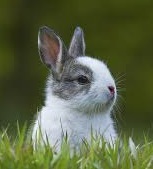
The European rabbit or common rabbit is a species of rabbit native to southwestern Europe (Spain and Portugal) and northwest Africa (Morocco and Algeria). It has been widely introduced elsewhere, often with devastating effects on local biodiversity. However, its decline in its native range (caused by the diseases myxomatosis and rabbit calicivirus, as well as overhunting and habitat loss), has caused the decline of its highly dependent predators, the Iberian lynx and the Spanish imperial eagle. It is known as an invasive species because it has been introduced to countries on all continents with the exception of Antarctica, and caused many problems within the environment and ecosystems. Australia has the most problems with European rabbits, due to the lack of natural predators there.
The European rabbit is well known for digging networks of burrows, called warrens, where it spends most of its time when not feeding. Unlike the related hares (Lepus spp.), rabbits are altricial, the young being born blind and furless, in a fur-lined nest in the warren, and they are totally dependent upon their mother. Much of the modern research into wild rabbit behaviour was carried out in the 1960s by two research centres. One was the naturalist Ronald Lockley, who maintained a number of large enclosures for wild rabbit colonies, with observation facilities, in Orielton, Pembrokeshire. Apart from publishing a number of scientific papers, he popularised his findings in a book The Private Life of the Rabbit, which is credited by Richard Adams as having played a key role in his gaining "a knowledge of rabbits and their ways" that informed his novel Watership Down. The other group was the Commonwealth Scientific and Industrial Research Organisation (CSIRO) in Australia, where numerous studies of the social behavior of wild rabbits were performed. Since the onset of myxomatosis, and the decline of the significance of the rabbit as an agricultural pest, few large-scale studies have been performed and many aspects of rabbit behaviour are still poorly understood.
Its natural habitats are subtropical or tropical dry forests and heavily degraded former forest.
Conservation status
Near threatened
Scientific classification |
|
| Kingdom: | Animalia |
| Phylum: | Chordata |
| Class: | Mammalia |
| Order: | Lagomorpha |
| Family: | Leporidae |
| Genus: | Oryctolagus |
| Specie: | Oryctolagus cuniculus |
Description
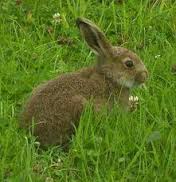
The European rabbit is a smallish, grey-brown (or sometimes black) mammal, although it ranks as medium-sized by lagomorph standards. It ranges from 34 to 50 cm (13 to 20 inches) in length, not counting a tail of 4 to 8 cm (1.6 to 3.1 in). Weight can range from approximately 1.1 to 2.5 kg (2.4 to 5.5 lb). As a lagomorph, it has four sharp incisors (two on top, two on bottom) that grow continuously throughout its life, and two peg teeth on the top behind the incisors, dissimilar to those of rodents (which have only two each, top and bottom). Rabbits have long ears, large hind legs, and short, fluffy tails. Rabbits move by hopping, using their long and powerful hind legs.
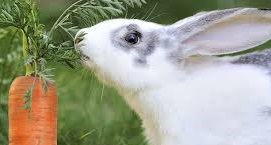
facilitate quick movement, a rabbit's hind feet have a thick padding of fur to dampen the shock of rapid hopping. Their toes are long, and are webbed to keep from spreading apart as the animal jumps.
Habitat
Rabbits are social animals, living in medium-sized colonies known as warrens. They are largely crepuscular, being most active around dawn and dusk, although they are not infrequently seen active during the day. During the day, rabbits prefer to reside in vegetated patches, which they use for protection from predators. At night, they move into open prairie to feed. Rabbit populations seem to be greatest in ecotone habitats and less in scrublands or grasslands. Rabbits in grasslands are preyed on by carnivores. Ecotone rabbits are preyed on by both.Rabbits require at least 55% water content in their diet to reproduce successfully and to maintain a healthy condition. Rabbits are essentially mixed-feeders, both grazing and browsing, but grass is their primary food source. They nevertheless have a diverse diet of grasses, leaves, buds, tree bark, and roots. They will also eat lettuce, cabbage, root vegetables, and grains. Birds of prey are their primary predators in scrublands.
Social organization
Rabbits live in warrens that contain two to 10 other individuals living in smaller groups to ensure greater breeding success. Territoriality and aggression contribute greatly to the rabbits maturation process and help ensure survival of the population. Mature male and females are better at fighting off predators. Females tend to be more territorial than males, although the areas most frequented by females are not defended. Rabbits mark their territories with dung hills. They expel soft, mucus-covered pellets that are sometimes reingested (coprophagy). They also expel larger pellets covered with secretions from the anal gland. A rabbit’s success in repelling strangers depends on the potency of the pellets. When young rabbits leave their natal warrens, they either settle in their pre-existing territories, take over unoccupied, formerly established territories, or become transients. Females tend to move into neighboring territories, while males tend to move further away.Rabbits can be extremely aggressive in the wild, and competition between males can often lead to severe injury and death. Although hostile displays are used, and males often squirt urine on challengers as a form of dominance, this nearly always enrages the challenger, resulting in immediate attack. Rabbits use their powerful back legs as weapons, kicking at an opponent's underside, as well as biting and scratching with the front paws.
Reproduction
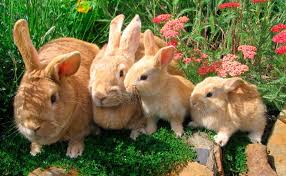
The male is called a buck and the female is a doe; a young rabbit is a kitten or kit.
The rabbit mating system is rather complex. Dominant males exhibit polygyny, whereas lower-status individuals (males and females) often form monogamous breeding relationships. Rabbits signal when they are ready to copulate by marking inanimate objects while giving off odoriferous substances though their chin gland, a process known as "chinning". Dominance hierarchies exist in parallel for both males and females. Social rank is based on the amount of group aggression. The dominant buck has greater mobility and more aggression than the dominant doe. This is likely because males have to fight each other for the females. The social hierarchy of males is also determined by a number of other factors, such as the size of his patrol area, the number of females that visit his area, resting time near females, the number of shelters he visits, and the distance he travels daily.
Rabbits are famed for their reproductive capabilities. Although certainly not the strongest, fastest, or smartest of the mammals, they have carved out a strong ecological niche through their rate of impregnation, because female rabbits ovulate at the time of copulation. One striking example of rapid rabbit reproduction took place in Australia, where the first 24 rabbits introduced in 1859 had multiplied to form a population of over 600 million over the course of less than a century.
The gestation cycle for a rabbit averages 31 days, although it can vary between 29 and 35 days. Litter sizes generally range between two and 12 rabbits. The young are born in a nesting burrow dug by the female, to which she returns once a day for four weeks for them to suckle. The rabbit's reproductive abilities were the inspiration for the phrase "breeding like rabbits". They can reproduce from three to four months of age. They can produce four to seven litters of offspring per year; a mature female can be pregnant continuously for up to eight months. One single pair of mature rabbits is able to produce 30-40 offspring per year. Kittens are born in a nest in an isolated part of the warren. The females build, prepare and defend the nest. A doe will mark the nest with urine and fecal dropping to deter others from invading the site. Does take care of the kittens without help from the bucks. However, bucks show considerable investment in the welfare of young, although much of this aspect of rabbit behavior is poorly understood. Males may be trying to enhance their social status by being surrounded by friendly individuals.
Domesticated rabbit
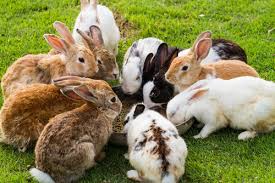
The only rabbit to be widely domesticated is the European rabbit, which has been extensively domesticated for food or as a pet. It was first widely kept in ancient Rome, where foetal rabbits were known as laurices and considered a delicacy, and has been refined into a wide variety of breeds during and since the Middle Ages.
Domesticated rabbits have mostly been bred to be much larger than wild rabbits, though selective breeding has produced a range sizes from "dwarf" to "giant", which are kept as food animals and pets across the world. They have as much colour variation among themselves as other livestock and pet animals. Their fur is prized for its softness; today, Angora rabbits are raised for their long, soft fur, which is often spun into yarn. Other breeds are raised for the fur industry, particularly the Rex, which has a smooth, velvet-like coat and comes in a wide variety of colors and sizes.
Zoológico de Vallarta A. C.
Leave your comments, your opinion is important to us

